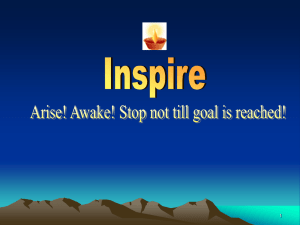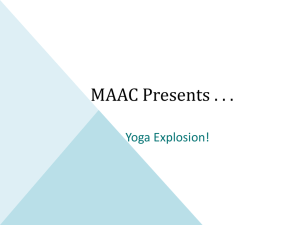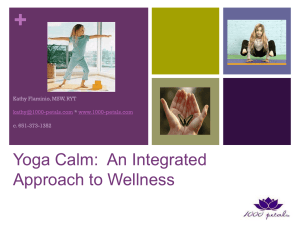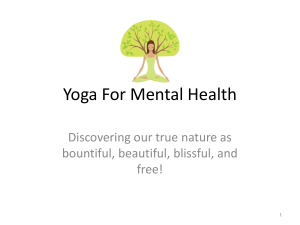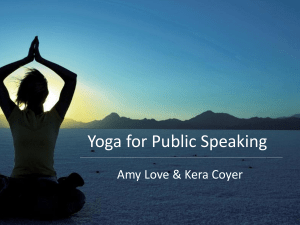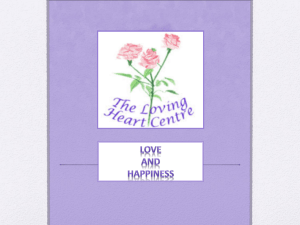Using Yoga to Enhance Coping and Spiritual
advertisement
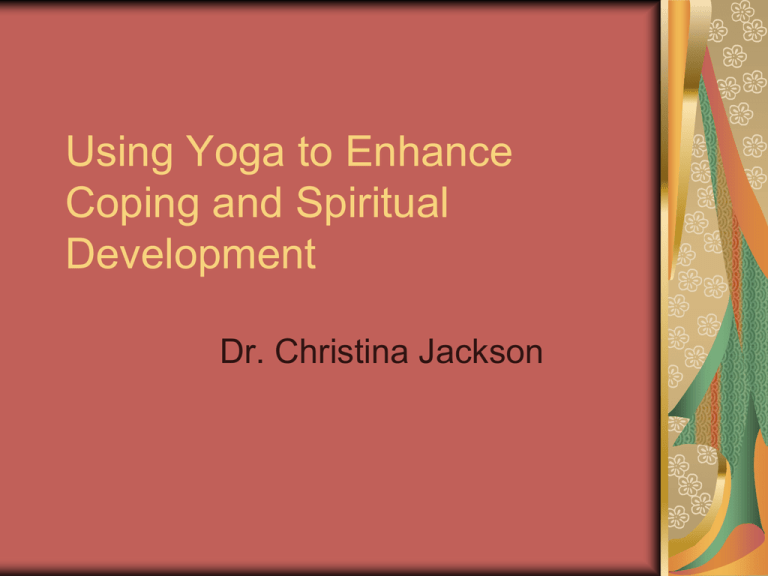
Using Yoga to Enhance Coping and Spiritual Development Dr. Christina Jackson Yoga means “to yoke” or “union” Person and the divine reality/God Body-mind-spirit What is yoga? A set of practices, including postures (asanas), breathing (pranayama), meditation (dhyana), and more Though not a religion, provides tools to prepare for spiritual enlightenment, facilitate religious experience and practice Patanjali’s Eightfold Path These practices can enhance acceptance and serenity Patanjali’s Eightfold Path (the 8 limbs of yoga) Yamas: Niyamas: Asana: Pranayama: Pratyahara: Dharana: Dhyana: Samadhi: Ethical guidelines Spiritual observances Physical postures Breathing exercises Turning senses in Concentration/focus Meditation Union, enlightenment Different styles of yoga… …focus on different aspects of the eightfold path Hatha yoga focuses on asanas and pranayama to achieve self-realization Karma yoga is a path to self-realization through selfless work and service to others Bhakti yoga (devotion to God) consists of meditation and prayer. The emphasis on devotion can be applied to any religious/faith practice. A robust body of evidence shows health benefits for those who belong to faith communities. Yamas Ahimsa: Asteya: Satya: Brahmacharya: Aparigraha: Non-violence/harm Non-stealing Truthfulness Moderation/Sexual restraint Non-greed/hoarding, non-attachment Niyamas Saucha: Santosha: Tapas: Svadhyaya: Ishvara Pranidhana: Cleanliness/purity Contentment Discipline Study of self or scripture Devotion/surrender to God Postures (asanas) Experiencing the body in new ways enables the practitioner to view the body and the world differently, thus gaining insight Seated awareness and body scan Mindful practitioners take the practice “off the mat” and into all aspects of life From The Mystic Heart by Wayne Teasdale “Yoga and the martial arts allow us to experience our connection with the natural world directly and intimately by stimulating our awareness of life energy that flows through us. Yoga is a spiritual practice…and places the person in a unique position to receive many insights and to access states of consciousness [usually] beyond reach…” Breathing awareness (ruach) Ujjayi breath Inhale fully through nose, exhale fully through mouth Diaphragm drops into belly “Ocean sound” at back of throat (as if fogging a mirror) Key Spiritual Issues Meaning and Purpose Love and Belonging Hope Guilt Faith/Belief/Doubt Forgiveness Mystery Transcendence Any disruption to physical or mental health triggers spiritual concerns An 18 year old high school track star tears a knee ligament. Surgery seems successful, and extensive rehabilitation begins. The student becomes increasingly irritable and withdrawn. Motivation to participate in physical therapy declines. The youth makes a suicide attempt. What body-mind-spirit issues/crises is this youth exhibiting? Bodily response Pain Reduced mobility Reduction in production of “feel good” peptides such as endorphins, serotonin, norepinephrine (our internal apothecary) Withdrawal from these natural “drugs” Mood instability Yoga can be practiced by anyone at any time! Even altering breathing patterns alters production of neurotransmitters and hormones (endorphins, serotonin, dopamine) Seated yoga experience Stretching, breathing, physically resisting in new ways becomes an “edge” experience and stimulates positive physiologic changes (PNI or psychoneuroimmunology) Molecules of Emotion ~ Dr. Candace Pert Mind responses Loss Fear Possible guilt or blame Disruption in goals and roles Reordering of daily schedule and rhythm Depression Anxiety Quell the inner critic and ANTS! “Yoga slows down the fluctuations of the mind” ~ Patanjali Spiritual responses Why did this happen? (meaning & purpose) Am I being punished? (guilt) Will I still fit in with my peers (fellow athletes)? Where will I belong now? (love and belonging) What can I do with my life now? What does my future hold? (M & P) Self-study (svadhyaya) Illness/disability offers an opportunity Asking existential questions invites one to go deeper, to examine perspectives Finding your “dharma”- what is meaningful, what is your path and higher purpose? But many seem unreceptive… Yoga practice is experiential and without using words… It invites pause, enhances receptivity, and increases awareness of inner wisdom Enhances insight “Be still and know that I am God” ~Psalm 46 But exactly how can we become more still? The Power of Pranayama Slow, deep breathing > Soothes the nervous system > Calms and shifts the mental environment > Enhances feelings of compassion, creativity, sense of connection, intuition, and receptivity to spirit > Healing and spiritual growth Abdominal breathing Compare movement over belly and ribcage (are you a reverse breather?) Follow your breath in and out -experiment with Pratyahara (withdrawal of the senses to inward focus) and Dharana (concentration) during this breathing exercise Attention to spine and hips during the breath- what happens to them? Complete (3-part) breath Expand belly, chest, shoulders on inhalation Exhale fully and slowly with awareness of deep abdominal muscles What does the research show? Improvements in psychological health measured as well being, mood, selfesteem, stress/anxiety reduction, sense of equanimity and balance in daily life, improved cognitive function, improved relationships and quality of life. Fosters spiritual growth measured as forgiveness, empathy, and transcendence of suffering and negative experience Community (Sangha) A valuable yoga concept found with increasing frequency in research Effectiveness of group support in health outcomes Dr. Dean Ornish’s work on those with heart disease and prostate cancer Dr. Jon Kabat-Zinn’s work using MBSR for myriad health challenges Cancer and yoga Many studies Ongoing research Improvements in body, mind and spiritual aspects of persons leading to improved immune function, cognitive restructuring and greater serenity The relationship between yoga and science “Ultimately, science and yoga should not be seen as competing. What yoga does well complements modern medicine’s strengths, providing more options for people in need of healing. While…yoga and medicine provide very different perspectives on health and disease, viewing the world through both paradigms can help you see reality more clearly and help you make more skillful choices” ~Timothy McCall, MD in Yoga as Medicine Essential equations: Pain + Resistance = Suffering Loss of Function+Resistance= Suffering (function= role, mobility, ability) Postures, breathing and meditation address resistance… Restless thoughts (monkey mind) Fear Past experiences Automatic negative thoughts (ANTS) Feelings of isolation (vs connection) Use awareness to ‘tune in’ to all aspects of self and shift resistance Breath Body scan ‘head to toes’ Feelings Thoughts Energy level Back to the body- release of tension through head, neck and shoulder movements Pain + Resistance = Suffering So, yoga practices reduce resistance Thoughts and emotional responses can inhibit or promote healing Even in the presence of ongoing pain or dysfunction, suffering will be reduced Quick techniques for chaplains/healthcare professionals to use for self-care Breath awareness and body scan to enhance mindfulness and full therapeutic presence Palming over eyes to release stress Third eye focus to access higher purpose and set intention Quick coherence technique to stimulate flow of compassion Quick bedside techniques to shift illness experience > reduce resistance > lessen suffering Synchronize your breath with client’s Teach belly breathing 4-2-4, 4-2-8 Teach palming exercise to relieve tension Head, neck and shoulder movements Positioning, eg. lowering chin when lying on back Guided imagery to access ‘special place’ of healing, and explore meaning “Where in your body are you feeling this emotion?” “What does this mean to you?” “What color is your pain? What color would it be if it was gone? Can you transform it?” Create a healing environment Music Nature Aesthetics (beauty) Build loving community (sangha) Health as expanding consciousness… Nursing theory developed by Margaret Newman, PhD, RN Non-judgment about illness experiencedetachment from outcomes Openness to growth in mind, body and spirit as a result of illness and at end of life Can be a stretch for many of those in our care We can create that space for them, imagine, and hold them in the light “…every yogi has grown old, and even though they are in remarkably good health, they still get sick and die...As these inevitable changes come, a yogi can be content with the fact that the physical body he or she has worked so hard to balance and gain subtle control over is really a temporary phenomenon.” ~ Richard Freeman, Yoga Workshop, Boulder, CO

